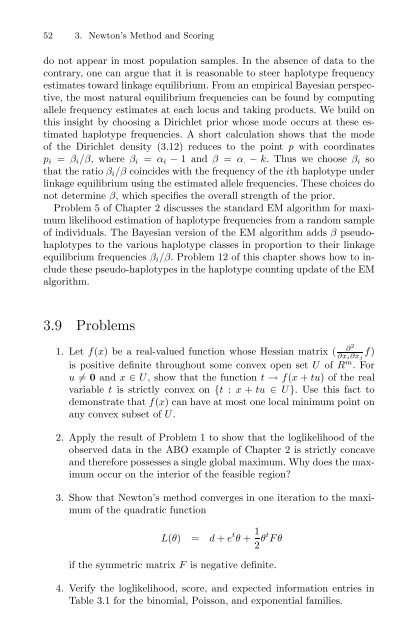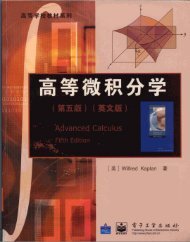- Page 1 and 2:
Applied ProbabilityKenneth LangeSpr
- Page 3 and 4:
Springer Texts in StatisticsAlfrd:
- Page 5 and 6:
Kenneth IangeDepartment of Biomathe
- Page 7 and 8:
viPrefacebringing up their children
- Page 9 and 10:
Preface to the First EditionWhen I
- Page 11 and 12:
A Few Words about SoftwarePrefacexi
- Page 13 and 14:
ContentsPreface to the Second Editi
- Page 15 and 16:
8.4 Multivariate Traits . . . . . .
- Page 17 and 18: 15.2 Review of Diffusion Processes
- Page 19 and 20: 2 1. Basic Principles of Population
- Page 21 and 22: 4 1. Basic Principles of Population
- Page 23 and 24: 6 1. Basic Principles of Population
- Page 25 and 26: 8 1. Basic Principles of Population
- Page 27 and 28: 10 1. Basic Principles of Populatio
- Page 29 and 30: 12 1. Basic Principles of Populatio
- Page 31 and 32: 14 1. Basic Principles of Populatio
- Page 33 and 34: 16 1. Basic Principles of Populatio
- Page 35 and 36: 18 1. Basic Principles of Populatio
- Page 37 and 38: 20 1. Basic Principles of Populatio
- Page 39 and 40: 22 2. Counting Methods and the EM A
- Page 41 and 42: 24 2. Counting Methods and the EM A
- Page 43 and 44: 26 2. Counting Methods and the EM A
- Page 45 and 46: 28 2. Counting Methods and the EM A
- Page 47 and 48: 30 2. Counting Methods and the EM A
- Page 49 and 50: 32 2. Counting Methods and the EM A
- Page 51 and 52: 34 2. Counting Methods and the EM A
- Page 53 and 54: 36 2. Counting Methods and the EM A
- Page 55 and 56: 38 2. Counting Methods and the EM A
- Page 57 and 58: 40 3. Newton’s Method and Scoring
- Page 59 and 60: 42 3. Newton’s Method and Scoring
- Page 61 and 62: 44 3. Newton’s Method and Scoring
- Page 63 and 64: 46 3. Newton’s Method and Scoring
- Page 65 and 66: 48 3. Newton’s Method and Scoring
- Page 67: 50 3. Newton’s Method and Scoring
- Page 71 and 72: 54 3. Newton’s Method and Scoring
- Page 73 and 74: 56 3. Newton’s Method and Scoring
- Page 75 and 76: 58 3. Newton’s Method and Scoring
- Page 77 and 78: 60 4. Hypothesis Testing and Catego
- Page 79 and 80: 62 4. Hypothesis Testing and Catego
- Page 81 and 82: 64 4. Hypothesis Testing and Catego
- Page 83 and 84: 66 4. Hypothesis Testing and Catego
- Page 85 and 86: 68 4. Hypothesis Testing and Catego
- Page 87 and 88: 70 4. Hypothesis Testing and Catego
- Page 89 and 90: 72 4. Hypothesis Testing and Catego
- Page 91 and 92: 74 4. Hypothesis Testing and Catego
- Page 93 and 94: 76 4. Hypothesis Testing and Catego
- Page 95 and 96: 78 4. Hypothesis Testing and Catego
- Page 97 and 98: 5Genetic Identity Coefficients5.1 I
- Page 99 and 100: 5. Genetic Identity Coefficients 83
- Page 101 and 102: 5. Genetic Identity Coefficients 85
- Page 103 and 104: 5. Genetic Identity Coefficients 87
- Page 105 and 106: 5. Genetic Identity Coefficients 89
- Page 107 and 108: 5. Genetic Identity Coefficients 91
- Page 109 and 110: 5. Genetic Identity Coefficients 93
- Page 111 and 112: 5. Genetic Identity Coefficients 95
- Page 113 and 114: 6Applications of IdentityCoefficien
- Page 115 and 116: Example 6.2.1 Siblings at the ABO L
- Page 117 and 118: 6. Applications of Identity Coeffic
- Page 119 and 120:
6. Applications of Identity Coeffic
- Page 121 and 122:
6. Applications of Identity Coeffic
- Page 123 and 124:
6. Applications of Identity Coeffic
- Page 125 and 126:
6. Applications of Identity Coeffic
- Page 127 and 128:
6. Applications of Identity Coeffic
- Page 129 and 130:
✓✒✏✑✓✒✏✑✓✒✏
- Page 131 and 132:
7Computation of MendelianLikelihood
- Page 133 and 134:
7. Computation of Mendelian Likelih
- Page 135 and 136:
✓✒✓✒✏✑✏✑✓✒✏
- Page 137 and 138:
7. Computation of Mendelian Likelih
- Page 139 and 140:
7. Computation of Mendelian Likelih
- Page 141 and 142:
7. Computation of Mendelian Likelih
- Page 143 and 144:
7. Computation of Mendelian Likelih
- Page 145 and 146:
✓✒✓✒✏✑✏✑7. Computat
- Page 147 and 148:
7. Computation of Mendelian Likelih
- Page 149 and 150:
7. Computation of Mendelian Likelih
- Page 151 and 152:
✓✒✓✒✏✑✏✑✓✒✓
- Page 153 and 154:
7. Computation of Mendelian Likelih
- Page 155 and 156:
7. Computation of Mendelian Likelih
- Page 157 and 158:
142 8. The Polygenic Modelidentity
- Page 159 and 160:
144 8. The Polygenic Model(h) If B
- Page 161 and 162:
146 8. The Polygenic Modelmatrix E(
- Page 163 and 164:
148 8. The Polygenic Modelcovarianc
- Page 165 and 166:
150 8. The Polygenic ModelTABLE 8.2
- Page 167 and 168:
152 8. The Polygenic Modelare hard
- Page 169 and 170:
154 8. The Polygenic Model8.9 The H
- Page 171 and 172:
156 8. The Polygenic Modelrecurrenc
- Page 173 and 174:
158 8. The Polygenic Model♠✉♠
- Page 175 and 176:
160 8. The Polygenic Model(b) Omitt
- Page 177 and 178:
162 8. The Polygenic Modelrandom sa
- Page 179 and 180:
164 8. The Polygenic ModelTo calcul
- Page 181 and 182:
166 8. The Polygenic Model[2] Barnh
- Page 183 and 184:
168 8. The Polygenic Model[28] Ott
- Page 185 and 186:
170 9. Descent Graph Methods9.2 Rev
- Page 187 and 188:
172 9. Descent Graph MethodsConvers
- Page 189 and 190:
174 9. Descent Graph Methodsis also
- Page 191 and 192:
176 9. Descent Graph Methods❧121/
- Page 193 and 194:
178 9. Descent Graph MethodsC D E F
- Page 195 and 196:
180 9. Descent Graph Methodsgenetic
- Page 197 and 198:
❛ ❛ ❛182 9. Descent Graph Met
- Page 199 and 200:
184 9. Descent Graph Methodsgraph C
- Page 201 and 202:
186 9. Descent Graph Methodsprocess
- Page 203 and 204:
188 9. Descent Graph Methods9.11 Th
- Page 205 and 206:
190 9. Descent Graph MethodsThe las
- Page 207 and 208:
192 9. Descent Graph Methodssimples
- Page 209 and 210:
194 9. Descent Graph Methodsand the
- Page 211 and 212:
196 9. Descent Graph Methodslocus t
- Page 213 and 214:
198 9. Descent Graph Methods11. For
- Page 215 and 216:
200 9. Descent Graph Methods[15] Ke
- Page 217 and 218:
10Molecular Phylogeny10.1 Introduct
- Page 219 and 220:
10. Molecular Phylogeny 205==(2n
- Page 221 and 222:
10. Molecular Phylogeny 207✁❆
- Page 223 and 224:
10. Molecular Phylogeny 20910.4 Rev
- Page 225 and 226:
10.5 A Nucleotide Substitution Mode
- Page 227 and 228:
10. Molecular Phylogeny 213satisfyi
- Page 229 and 230:
10. Molecular Phylogeny 215most eco
- Page 231 and 232:
10. Molecular Phylogeny 217TABLE 10
- Page 233 and 234:
10. Molecular Phylogeny 219reversib
- Page 235 and 236:
10. Molecular Phylogeny 221so forth
- Page 237 and 238:
10. Molecular Phylogeny 223TABLE 10
- Page 239 and 240:
10. Let A and B be the 2 × 2 real
- Page 241 and 242:
10. Molecular Phylogeny 227this rev
- Page 243 and 244:
10. Molecular Phylogeny 229[14] Lak
- Page 245 and 246:
232 11. Radiation Hybrid Mappingon
- Page 247 and 248:
234 11. Radiation Hybrid Mapping1 2
- Page 249 and 250:
236 11. Radiation Hybrid Mappingpro
- Page 251 and 252:
238 11. Radiation Hybrid Mappingpar
- Page 253 and 254:
240 11. Radiation Hybrid Mappingtha
- Page 255 and 256:
242 11. Radiation Hybrid Mappingvie
- Page 257 and 258:
244 11. Radiation Hybrid MappingSim
- Page 259 and 260:
246 11. Radiation Hybrid Mappingthe
- Page 261 and 262:
248 11. Radiation Hybrid Mappingpri
- Page 263 and 264:
250 11. Radiation Hybrid MappingInt
- Page 265 and 266:
252 11. Radiation Hybrid MappingSho
- Page 267 and 268:
254 11. Radiation Hybrid Mapping[4]
- Page 269 and 270:
12Models of Recombination12.1 Intro
- Page 271 and 272:
12. Models of Recombination 259dist
- Page 273 and 274:
= 1 212. Models of Recombination 26
- Page 275 and 276:
12. Models of Recombination 263]+ 2
- Page 277 and 278:
12. Models of Recombination 265lies
- Page 279 and 280:
12. Models of Recombination 267left
- Page 281 and 282:
12. Models of Recombination 269matr
- Page 283 and 284:
12. Models of Recombination 271In t
- Page 285 and 286:
12.7 Application to Drosophila Data
- Page 287 and 288:
12. Models of Recombination 275If G
- Page 289 and 290:
12. Models of Recombination 2779. I
- Page 291 and 292:
12. Models of Recombination 279[12]
- Page 293 and 294:
13Sequence Analysis13.1 Introductio
- Page 295 and 296:
13. Sequence Analysis 283using the
- Page 297 and 298:
13. Sequence Analysis 285simpler re
- Page 299 and 300:
13. Sequence Analysis 287run entire
- Page 301 and 302:
13. Sequence Analysis 28913.5 Paral
- Page 303 and 304:
13. Sequence Analysis 291gap score
- Page 305 and 306:
13. Sequence Analysis 293alignment
- Page 307 and 308:
p R s mF (s) =p R s m +(1− s)Q(s)
- Page 309 and 310:
13. Sequence Analysis 297[8] Sankof
- Page 311 and 312:
300 14. Poisson Approximationin I [
- Page 313 and 314:
302 14. Poisson Approximationgene i
- Page 315 and 316:
304 14. Poisson Approximationestima
- Page 317 and 318:
306 14. Poisson Approximationapprox
- Page 319 and 320:
308 14. Poisson ApproximationIt fol
- Page 321 and 322:
310 14. Poisson ApproximationThe Ch
- Page 323 and 324:
312 14. Poisson Approximationof mat
- Page 325 and 326:
314 14. Poisson Approximation10. Co
- Page 327 and 328:
316 14. Poisson Approximation[10] G
- Page 329 and 330:
318 15. Diffusion Processesrather t
- Page 331 and 332:
320 15. Diffusion Processes∫ ∞=
- Page 333 and 334:
322 15. Diffusion Processeslation g
- Page 335 and 336:
324 15. Diffusion ProcessesIt follo
- Page 337 and 338:
326 15. Diffusion Processesfor X 0
- Page 339 and 340:
328 15. Diffusion Processes=≈=k 4
- Page 341 and 342:
330 15. Diffusion Processesc i+1,k
- Page 343 and 344:
332 15. Diffusion Processesc ij→i
- Page 345 and 346:
334 15. Diffusion Processesgrown ex
- Page 347 and 348:
336 15. Diffusion Processesand the
- Page 349 and 350:
338 15. Diffusion Processes11. Supp
- Page 351 and 352:
Appendix A: MolecularGenetics in Br
- Page 353 and 354:
A.2 From Gene to ProteinAppendix A:
- Page 355 and 356:
A.3 Manipulating DNAAppendix A: Mol
- Page 357 and 358:
Appendix A: Molecular Genetics in B
- Page 359 and 360:
Appendix A: Molecular Genetics in B
- Page 361 and 362:
Appendix B: The NormalDistributionB
- Page 363 and 364:
matrix I, and characteristic functi
- Page 365 and 366:
IndexABO locus, see Blood group loc
- Page 367 and 368:
Index 357Coupling × repulsion mati
- Page 369 and 370:
Index 359preorder traversal, 208roo
- Page 371 and 372:
Index 361relation to disease risk,
- Page 373 and 374:
Index 363Meiosis indicators, 189MEN
- Page 375 and 376:
Index 365Pulley principle, see Fels
- Page 377 and 378:
Index 367Stationary distribution, s
- Page 379:
ALSO AVAILABLE FROM SPRINGER!NUMERI
















